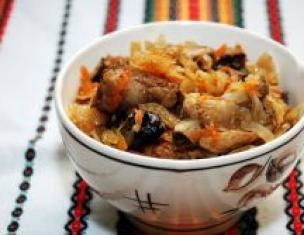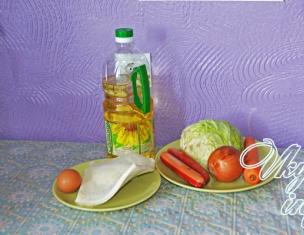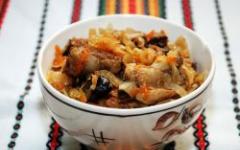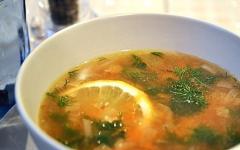Stew is a colloquial name. canned meatwhich is cooked with the help of quenching. Properly cooked stew can be stored for years, which makes it a regular dish that saves housewives due to lack of time. In the store it is recommended to choose stew, which is made according to GOST - so you will be sure of the quality of the product. If you do not trust the store products, you can make homemade stew.
Homemade beef stew: recipe
Composition:
- Beef - 2 kg
- Salo - 400 g
- Salt - to taste
- Bay leaf - to taste
Cooking:
- To get homemade stew delicious, beef must be fresh, not frozen. Cut the meat into small pieces, put them in a saucepan, add salt and put on a slow fire. Water is not recommended to add, because in the process of cooking the meat will give juice. Simmer the meat under the lid, remembering to stir occasionally. On average, the process of quenching takes about 5 hours.
- After 2 - 3 hours of stewing, finely chop half the fat and add to the beef pan in the pan. At the end of cooking, add peppercorns and bay leaves.
- In a separate bowl, melt the 2nd half of the bacon. Put the finished meat in sterile glass jars, cover with melted lard and close tightly with the lid.
- Homemade beef stew is ready, you can use it when cooking potatoes, pasta, soups and other dishes.
Pork stew: how to cook?

Composition:
- Pork - 1 kg
- Salo - 500 g
- Bay leaf - to taste
- Salt and pepper - to taste
Cooking:
- Cut the pork into small pieces, salt, pepper and mix well. At the bottom of the sterilized jar, place the bay leaf, firmly place the pieces of meat, cover the jar with a lid and place in a cold oven.
- Turn on the oven at 250 degrees, bring the meat to a boil, then reduce the temperature to 150 degrees and cook for 3 hours.
- While the stew is stewing, cook the bacon. To do this, cut it into small pieces, over a low heat, heat the fat and pour it into a separate dish.
- When you get the meat out of the oven, fill it with fat, roll up the jar and cool. Store the prepared stew in a cool place (in the basement, cellar or refrigerator).
Homemade chicken stew

Composition:
- Chicken thighs - 1.5 kg
- Chicken Breast - 1 kg
- Salt and spices - to taste
- Bay leaf - to taste
- Black pepper peas - to taste
Cooking:
- Chicken stew is ideal for people who do not like fatty meat. Wash chicken legs and brisket, peel and bones.
- Cut the meat into small pieces, put in a saucepan, add salt and spices to taste. Mix well and refrigerate for 40 minutes.
- At the bottom of the cans lay a bay leaf and peppercorns. Tamp down chilled chicken meat and close the lid.
- Cover the bottom of the pan with a towel, put the jars on top, fill them with water so that it does not reach the lids a few centimeters.
- Cover the pan with a lid and put on a strong fire.
- When the water boils, reduce the heat and extinguish for 4.5 hours. As the water boils away, add a new one.
- When the stew is ready, remove the jars from the pan, tightly screw the lids and cool at room temperature. Store chicken stew can be about six months.
How to cook stew in a slow cooker?

Composition:
- Lamb - 1 kg
- Salt and spices - to taste
- Black pepper peas - to taste
- Bay leaf - to taste
Cooking:
- Wash the lamb and cut it into large enough pieces. Put the meat in the bowl of the slow cooker, bring to the boil in the baking mode (about 15 minutes).
- Then, salt, add peas and bay leaf. Put the slow cooker in fire mode for 5 hours.
- When time runs out, the meat will easily diverge into fibers and can be crushed with a spatula. Bring the boiled meat to the boil again. Lay out the finished lamb in sterilized jars, close tightly, cool and store in the refrigerator.
Rabbit Stew: Recipe
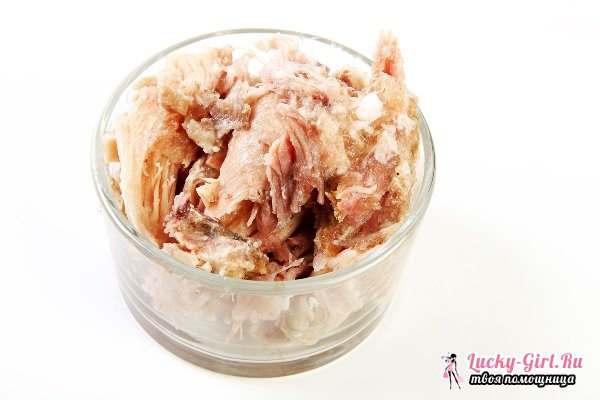
Composition:
- Rabbit carcasses - 3 pcs.
- Carrots - 3 pcs.
- Salt - to taste
- Black pepper peas - to taste
Cooking:
- Soak the carcasses of rabbits in cold water about 2 h until complete bleeding of meat. After, let the water drain, divide the carcass into parts, cut off the fat and put it in a separate dish. Cut the meat into small pieces and set aside bones from the carcasses. Put black peppercorns in sterilized jars.
- Place the bones from the rabbit meat in a saucepan, add salt, carrot pieces, pour water, put on the fire and cook as usual aspic.
- Spread the rabbit meat over the jars, cover with a lid, put on a baking sheet with salt and place in a cold oven. Set the temperature to 150 degrees and cook the stew about 2 to 3 hours after boiling.
- While the meat is stewing, melt the rabbit fat in a saucepan. Remove the jars of stew, remove the lids, add salt, pour in the hot broth and melted lard.
- Roll banks and leave to cool. Rabbit stew can be stored up to 1 g at room temperature.
The first canned stew appeared in the 19th century and quickly began to gain popularity. Homemade product is more fragrant, tasty and natural than the store counterpart. it universal workpiece, which can be used in soups, cereals and as a separate dish. Store homemade stew can be no more than a year in a cool place.
Canned stewed meat - meat cooked by stewing. Stew in the colloquial language called canned stew.
Stew meat itself is a finished product, so when cooking with stew it is added last, 5 minutes before the end of cooking.
This is one of the best meat products in a situation where cooking fresh meat unavailable due to lack of time, limited space in the refrigerator and for other reasons.
Such meat can be stored for years, while maintaining its nutritional value. Stew can be prepared from fresh pork, beef, lamb, rabbit and poultry.
Technology of cooking stew
For beef stews, fresh beef in large pieces (fillets) is preferable. Fit and already chopped meat - azu or goulash. Veal, although it is considered a dietary product, clearly loses to beef in its taste properties, as well as on the "protein" of the product.
It is highly undesirable to buy frozen meat. To keep the stew for a long time, cooked meat is poured on top of fat.
By itself, beef usually does not contain the right amount of fat, so when cooking beef stews use fat of a different origin, such as lard. In the process of cooking, beef is boiled down by about 40%. If you do pork stew, the fat can be cut from the purchased meat, and at the end of cooking, melt and pour the stew.
The container must be sterile - it must be boiled (or at least pour boiling water) and dried. Glass jars are best suited for long-term storage. Covers can be used both plastic and tin rolls. So that the covers do not rust, it is desirable to grease them on top with any grease.
Keep the stew in a cool cellar or similar place. With normal cooking, homemade stew can be stored for about five years.
Fresh pork steak, beef or lamb
A stew can be made from fresh pork, beef or lamb using the same recipe. At home, it is more convenient to preserve the stew in half-liter or liter glass jars and roll up with tin lids.
Banks and covers are pre-sterilized in boiling water. For heat treatment it is preferable to use the oven. Meat cut into large chunks of the same size, salt to taste. At the bottom of each jar, place 1 bay leaf, 10 peas of black bitter pepper, fill the jar with prepared meat, evenly distributing fatty and lean pieces, add internal fat to the jars.
Cover tightly filled jars with glass lids, place on a baking sheet and place in an oven preheated to 200 ° C. Pour a layer of coarse salt on a baking tray. After boiling the contents of the jars, soak in a preheated oven for about 2 hours, then remove and roll up sterile lids.
Beef stew 1
To prepare a stew, you need to take the meat without bones, lived and veins, cut it into pieces of medium size, put in a pan and pour 1-1.5 cm water above the meat level. Put the pot on the fire. After boiling water, remove the foam. Add 10 black peppercorns, 2 sliced onions, parsley, one chopped carrot and cook over low heat. After 2 hours, slightly salt the meat, remove the onions.
After another 1-2 hours, when the meat is completely ready (pierced freely with a fork), dosolit to taste, put 2 bay leaves, boil for another 15 minutes, then remove the bay leaf. Without turning off the fire, take out the meat and put it into sterilized pre-sterilized glass 0.5-1 liter jars and pour the broth to the brim, then roll the jars with tin lids, turn them over and leave to cool.
Beef Stew 2
Wash the meat, cut it into pieces, put in a bowl, sprinkle with salt and let stand 30 minutes. Sterilize the jars liter or half-liter and sterilize the lids, spread the meat there, cover with lids and put in a cold oven.
Do not add liquid, meat will give its juice. Stew meat for 2.5-3 hours. In the process of cooking the meat will sit down, then from one jar add to the rest to the top. Only do everything with a sterilized spoon. Then get out of the oven and roll up. Put a day in something warm, like in a bath.
Beef stew 3
900 g beef pulp, 6 bay leaves, 2-2.5 hours spoon of salt, 1 hour spoon of ground black pepper, 50 g of fat.
Cut meat into large pieces. Beat off on all sides. In a 1.5 liter container (for example, a glass jar or clay pot) put 4 bay leaves. Capacity for extinguishing need to take thick-walled and vertically elongated. If you stew in a flat pan, the meat will rise high above the selected juice.
In this case, have to add a lot of water. The result will be boiled, not stewed meat. In addition, it will be more rigid. Sprinkle the beef cuts with salt and pepper. Tightly lay in a jar. Finely chop the bacon and place it on top of the beef. Lay bay leaves on the top. The neck of the jar is tightly capped with foil in several additions.
Put the jar in a small frying pan or pot. Place the griddle in a cold oven on the lower level. Set the temperature to 180 ° C and simmer for 3 hours.
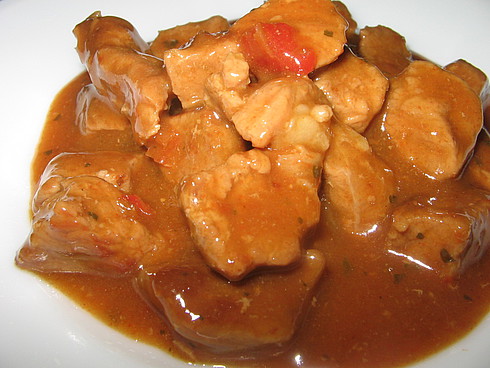
Pork Stew
Take clean meat without bones. Lightly fry in homemade butter (until the water disappears), then salt. After that, put the meat pieces in the jar. Put the jar in a saucepan with water, boil for 1.5 hours. Spices: 1 bay leaf, black peppercorns 5-7 pcs. put before closing. The jar and lid must be sterilized. Close the jar with a hermetically sealed machine and put the lid down until it is completely cooled.
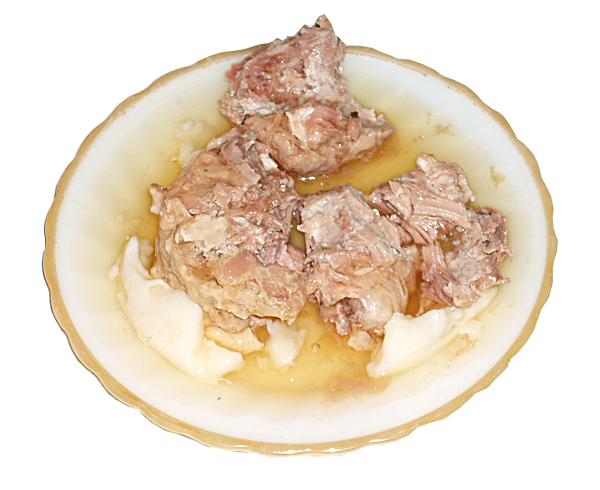
Mutton stew
Fry the lamb pieces lightly, then stew them until ready. At the same time add salt and spices to taste. Already cooked lamb is poured into a container and poured with previously melted lamb fat. So that the fat covered the pieces. Then you seal the container properly.
Chicken Stew
For the stew, you can use fresh chicken meat with bones. Wash the gutted and scorched chicken carcass, remove all skin from it.
Then cut the carcass into large pieces, salt and put into sterile glass jars, adding the inside chicken fat (if any), spicy dry greens of marjoram or savory, 1/4 tsp of turmeric, 10 black peas hot pepper. Place the jars on a baking sheet on a layer of coarse salt, cover with lids (lids for temporary use, only for stewing in the oven!).
Place a baking tray with jars in an oven preheated to 200 ° C and let the mass stand in the jars after boiling for at least 2 hours, then remove and immediately roll up the sterile lids. In the same way, you can cook stew of goose, turkey, duck.
Rabbit stew
Prepare an enamel tank with a capacity of 25 liters. Put a wooden circle on the bottom. Cook seven liter cans (just as many of them fit in the tank) and seven metal covers. Sterilize jars and lids for 10 minutes over a boiling kettle.
Using a sharp knife, remove the meat from 4-5 rabbit carcasses. It will be enough to fill the jars. Separate the inner fat of the rabbits and put them in a separate dish. If the carcasses of rabbits are not fat, then cook a little fat pork meat (bacon), cutting it into pieces with walnut. At the bottom of each jar, place 1-2 well-washed and spiked bay leaves and inner rabbit fat or lard in a layer of 2 cm.
Then put the rabbit meat tightly in the jars. Put 3-4 peas of allspice in each jar, 5-6 pieces of black pepper or ground black pepper, 2-3 pieces of cloves for other available spices.
Add a teaspoon of salt to each jar. Cover the top of the meat with rabbit fat or lard 2-3 cm thick. Fill the jars to the brim, cover them with lids and place them in the tank so that they do not touch each other and the walls of the tank. Fill the tank with warm water up to the hanger cans and put on low heat. As the water in the tank and the meat and jars heat up, increase the burner flame, and when the water boils, adjust the fire so that the water does not boil too much and not splash the jars.
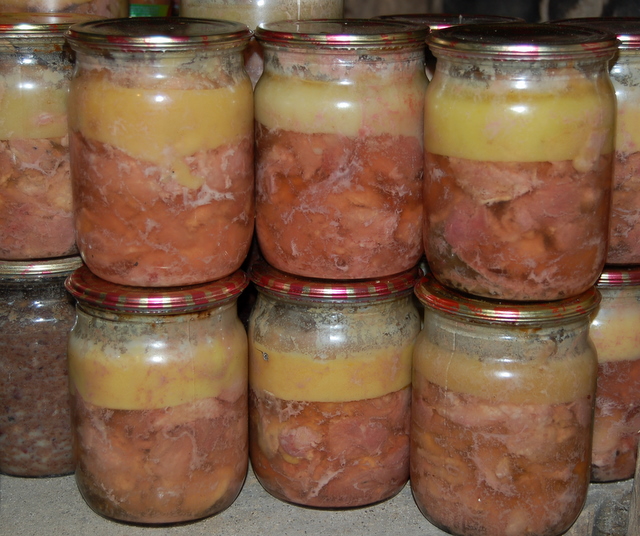
To prevent the lids from rising and lying tightly on the cans, place a wooden circle on top of them so that it covers the covers of the entire battery by about half or a bit more. Close the tank tightly with a lid.
From time to time, adjust the degree of boiling water, and use a knife blade to straighten the jars so that they do not touch the walls of the tank. 5 hours after the start of boiling water, reach the jars and, without raising the lids, roll up.
Shake the finished jar slightly, so that its contents are mixed. Do this carefully and not very sharply - to avoid knocking the lid off. Then turn the jar upside down and listen carefully if there is a hiss. Otherwise, such a jar once again, roll with a machine for rolling the covers and mark.
It is better not to keep it for a long time and, if necessary, open it first. If everything was done in good faith and cleanly, then the stew can be stored for a long time, maintaining its excellent taste. If the stew is prepared in half-liter jars, then the sterilization time in the steam-water “bath” is reduced, respectively, by half.
A stew is meat that is made by stewing. That is, it is canned stew. it finished productTherefore, when dishes are prepared, they are added at the very end. Stew can be stored for years, and at the same time preserve nutritional value. It is made from poultry, rabbit, lamb, beef and pork.
Technology of cooking stew
To make beef stew, it is better to buy beef in large pieces (fillets). Also fit sliced meat - goulash or azu. Although veal is considered a dietary product, it clearly loses in the “protein content” of the product and in taste properties of beef. It is highly undesirable to purchase frozen meat. To keep the stew as long as possible it is necessary to fill with fat. In the beef itself there is not so much fat, so they use fat of other origin, for example, lard of the pig. During cooking, beef meat is reduced by 40%. If you are cooking pork stew, then you can cut the fat from the meat you bought, and at the end of cooking, just melt it and fill the stew. Container is needed sterile - it must be boiled and dried. If you are going to leave it for long-term storage, then glass jars are best suited. Covers are suitable, both tin rolled and plastic. So that the covers do not rust, grease them on top. Keep the prepared stew in a cool place. It, during normal preparation, can be stored for five years.
Fresh mutton stew of beef or pork
A stew can also be made from fresh mutton, beef and pork using one recipe. It is better to preserve it at home in liter or half-liter glass jars and close with tin lids. Caps and jars are pre-sterilized in boiling water. For warm processing it is better to use the oven. Cut the meat into large chunks of approximately the same size, salt to taste. At the bottom of all the cans, one bay leaf, ten peas of bitter black pepper, fill the jar with meat, spreading the lean and fatty pieces evenly, and then add the fat. Cover the tightly filled jars with lids, put them on a baking sheet, sprinkled with coarse salt beforehand, and stick them in the oven, preheated to 200 ° C. After boiling the stew, you should soak for about two hours in the oven, and only then remove and roll up sterile lids.
Beef stew recipe 1
Take the beef without streaks, lived and bones, cut into small pieces, put in a saucepan and cover with water a centimeter above the level of meat. Then put it all on fire. As soon as it begins to boil, begin to remove the foam. Then add ten peas of black pepper, sliced carrots, parsley, two onions cut in half and cook over low heat. Two hours later, a little salt and remove the onions. After another half hour, when the meat is cooked (easily pierced), put two bay leaves, add salt to taste and simmer for about fifteen minutes, then take out the bay leaf. Without turning off the fire, take out the meat and put in sterilized liter or half-liter jars and cover with the broth to the brim. Then roll up the tin lids, turn them over and leave to cool.
Beef Stew Recipe 2
Wash the meat, cut into pieces, sprinkle with salt and leave in a basin for about thirty minutes. Sterilize jars and lids, put the meat in there, cover with lids and put them in a cold oven. No liquid needs to be added, the meat itself will give juice. Simmer for two and a half to three hours. The meat in the cooking process will sit down, then pour it from one can into the others. Do everything only with a sterilized spoon. Then remove from the oven and roll up. On the day, put in something warm, like a bath.
Pork Stew
Take only boneless meat. Fry a little on homemade butter (so that the water disappears), then salt it. After that, put the pieces in a jar. Put in a pot of water and boil for about an hour and a half. Spices: five to seven pieces of black peppercorns and bay leaves. The lid and jar need to be sterilized. With a machine, hermetically close the jar and place the lid down until it is completely cooled.
Mutton stew
Fry the lamb pieces lightly, then simmer until tender. During this, add spices and salt to taste. Already cooked lamb, throw in a container and cover with vegetable lamb fat so that the pieces are covered with fat. After that, properly close the container.
Chicken Stew
For stew, chicken meat can be used along with bones. Wash scorched and gutted hen, remove all skin. Then cut into large pieces, salt and place in glass jars. Add chicken fat (if any), ten peas of hot black pepper, one-fourth teaspoon of turmeric, spicy dry herbs of savory or marjoram. Place the jars on a baking sheet, which is sprinkled with coarse salt, cover with lids (they are only needed to extinguish). Put it all in the oven, preheated to 200 ° C and keep after boiling for at least another two hours. After that, remove and immediately roll up the sterile caps. Also preparing the stew of duck, turkey and goose.
Rabbit stew
Prepare an enamel tank of 25 liters, seven liter cans and seven metal lids. Put a wooden circle on the bottom. Lids and a jar must be sterilized over a boiling kettle for about ten minutes. A sharp knife should remove the meat from four to five carcasses of rabbits. That's enough to fill the jars. Separate rabbit fat and place separately. If they are not fatty, then you should make a little pork fatty meat (lard), cutting it into pieces of walnut. At the bottom of all the cans, place one or two starched and well-washed bay leaves and lard or rabbit fat in a layer of two centimeters. After that, put the rabbit meat tightly in jars. In all the jars, put two or three cloves, five or six pieces of black pepper peas, and three or four pepper peas. And also add a teaspoon of salt. Pour over the lard or rabbit fat two or three centimeters thick. As soon as the cans are filled to the brim, cover them with lids and place them in the tank so that they do not touch each other and the walls of the tank. Fill it up to the shoulders of cans with warm water and put on a slow fire.
As the meat, water in the tank and the cans are heated, increase the flame, and when the water boils, screw the fire in so that the water does not boil too much and not splash the cans. So that the lids lie tightly on the banks and do not lift, put a wooden circle on top of them so that it covers all the banks. And close the tank tightly with a lid. Sometimes adjust the degree of boiling water, and straighten the jars with a knife blade so that they do not touch the tank. Five hours after the start of boiling, remove the jars and roll them up without lifting the lids. Roll the jar a little shake to mix the contents. Do this not very sharply and carefully - so that the cover does not fly off. Then turn it upside down and listen for hissing. If there is, then such a bank needs to be re-rolled with a typewriter and marked. Better not keep it long and open first.
Video lessons
Canned food has a rich history. After all, the first attempts to preserve products for their longer storage were used already in the times of Tutankhamen: archaeologists have found an analogue of modern canned food during excavations. Naturally, the development of canning significantly expanded the possibilities of people. For example, it became possible to go on long hikes without the threat of spoiling health from malnutrition. In most cases, a ready-made stew is bought. However, such a product (and it will be an order of magnitude tastier and healthier) is quite possible to prepare yourself.
Cooking homemade beef stew
Home-made stew is a guarantee that natural meat is used in the preparation of canned food. So, this dish will be both useful and nutritious. At the same time, its big plus is that for cooking beef stew itself is not required a large number products.
The recipe for homemade beef stew
Before you start cooking the stew, you need to choose the right meat. After all, not every part of the cow carcass can be fully preserved. It is best to choose a sirloin. As an option, you can stop already on the cut blanks, such as azu or goulash. But it is not recommended to take veal meat: despite the fact that it is considered more dietary and tender, it is noticeably inferior to beef in taste.
Naturally, there is no question of using frozen meat for cooking stews. First, such meat can be old and dry. Secondly, frozen beef does not have the desired taste.
Remember that in the process of cooking the meat is reduced by 40%. Therefore, take it more than you need a ready-made stew. It is also necessary to prepare in advance the lard, with which you will pour the prepared stew to keep it better.
For the preparation of homemade stew, you will need: - Beef - 1 kg; - pork lard - 200 g; - bay leaf - 10 pcs .; - spices; - peppercorns to taste.
Wash the meat, dry well and cut into large pieces. Fat cut into small cubes. Salt the meat, pepper and sprinkle with spices. Next, take the jar (it is best to use half-liter and liter). At the bottom, put a few leaves of laurel, then put the meat. Top with a crown design of lard and peppercorns, as well as the remaining bay leaves.
Remember that the pot must be sterile. Therefore, before you start laying products into it, be sure to sterilize the container. In addition, it is desirable to additionally lubricate the cover with grease so that it does not oxidize.
Cover with foil so that in case of excessive appearance of juice from meat, it does not sprinkle in all directions in the oven and does not chadil. After put the jar in a cold oven and turn it on to warm up to a temperature of 180 degrees. When you realize that the oven is well heated, reduce the temperature to 160 degrees and leave to stew for 3 hours. Try not to open the door at this time, so that the bank will not break due to the temperature drop. After the time, turn off the oven, but do not open the door and do not reach the stew until it cools. When you get out of the oven roll up the lid and store for storage in a cool place, like a cellar.
Cook beef stew can be another way. For this, meat is enough to cook. And this is not as difficult as it seems. To prepare such a stew, you will need: - Beef - 2 kg; - salt, pepper to taste; - bay leaf - 2 pcs .; - water - 2 tbsp.
Cut the beef meat into slices and put it in a saucepan. Then add water and put the meat on the fire, let it boil. Then reduce heat to low and leave meat to stew. After 3-4 hours, salt and add spices. Leave to cook for another couple of hours. Try to open the pot less often. Turn off the stove and leave the stew to cool. After transfer to the prepared jars and roll up.
What to consider when cooking homemade stew
One of the popular wisdoms and the experience of not one generation of housewives say that it is not worthwhile to preserve women who have critical days.
Store the finished product in a cool and dark place. Subject to all conditions, the home canned meat can be stored for about 5 years.
How to cook stew at home video recipe - step by step
Below you will meet step by step video recipe that will help you when cooking.
Having all the necessary ingredients and using our tips from this article, you easily and (hopefully) cook with pleasure this wonderful dish.
See other recipes:
Tags of this dish ::
Meat stew is an excellent delicacy that you can cook with your own hands, at home. Her recipe is extremely simple, and at the exit you get delicious dish, which can be consumed in a separate version, or added to various rich soups, porridge and stews.
Beef stew can become something of a “strategic stock” for you, and when you go camping or have a picnic, you can grab a jar of delicacy with you.
Homemade stew is tasty, simple and healthy, so we strongly recommend that you try to cook it yourself. It is best to do this in an ordinary oven, although some prefer to cook beef stew in an autoclave, a slow cooker and other appliances.
In fact, it is most acceptable to cook the preservation in the oven. The cooking methods in the autoclave, the slow cooker and the oven certainly differ among themselves. So, how can you make a delicious, juicy and flavorful beef stew at home?
Choosing meat for preservation
First of all, in order for your canning to turn out really tasty, nourishing and appetizing, you should choose the “right” meat. This requires any recipe for this dish.
It's no secret that modern standards for the production of canned food on an industrial scale are far from ideal. Now nothing is prepared according to GOST, and therefore you can not be sure of the quality of the purchased products. In fact, in canned food produced in the factory, not the best quality meat is put. This is something like a waste-free production, for which we pay not only money, but also our own health. Apart from the fact that low-grade raw materials are used for ordinary factory stews, we should not forget about the ubiquitous additives and flavor enhancers, which also do not inspire any confidence.
To make your preservation tasty, choose to cook it fresh, young meat. But veal for these purposes is not recommended to buy. Despite the fact that this meat is considered the most dietary, tender and useful, in preservation it is much inferior to traditional beef in taste.
It should be understood that not every part of the cow carcass will be equally suitable for canning. The most acceptable would be the acquisition of a beef sirloin, in which there are no bones and large veins. Be sure to make sure that the meat is fresh - in no case should it be weathered and have a foreign smell. Ideal if you can get the product right from the hands of farmers.
It is out of the question to purchase a frozen piece of meat for cooking. First, after defrosting it may be that it is old and dry. And secondly, frozen and thawed beef will lose all their taste properties, which are mandatory for high-quality preservation.
Meat preparation
After buying high-quality meat, it will be necessary to prepare it at least qualitatively for further suppression. Remember that in the process of cooking the product will be almost full by half, which means that you should purchase about 40% more than you want to get stews.
In any recipe for beef stew at home, there is a phased preliminary preparation of the main raw materials:
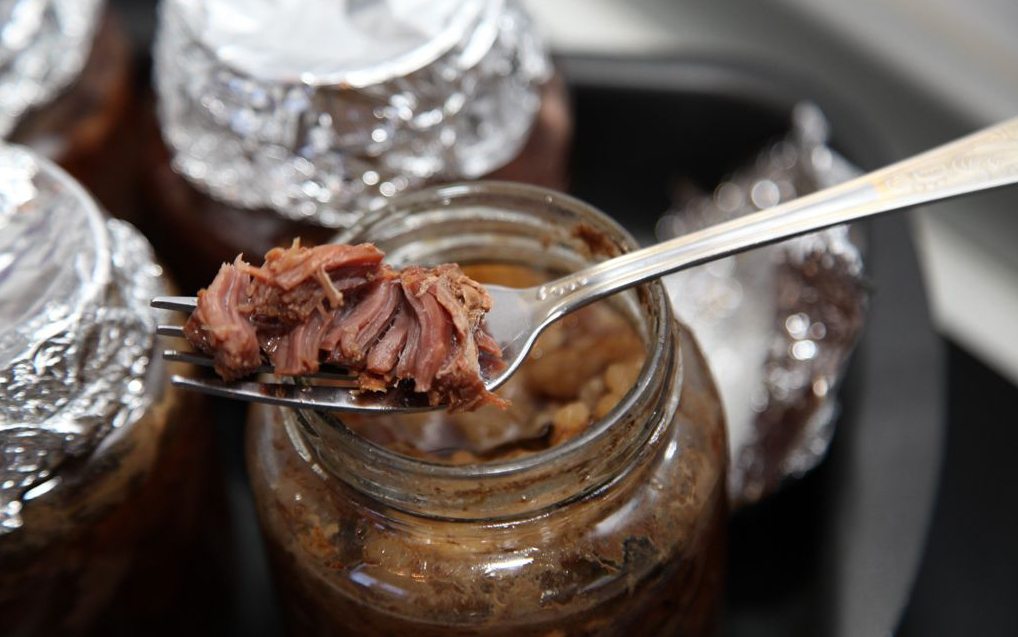
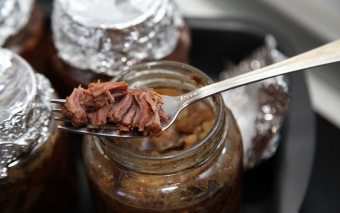
- Remove the veins and bones, if any;
- Buy lard separately. When cooking meat in a pan or a slow cooker, it will need to be melted for further preservation. So the finished dish can be stored longer, and in addition, will acquire savory taste. Crush it in miniature cubes;
- Beef cut into larger pieces, preferably even;
- Decide in advance on what seasonings and spices will be present in your preservation.
You just have to decide exactly how your dish will be cooked. We have already mentioned that the meat can be cooked separately in any convenient way, and only then can it be rolled into jars. But much more acceptable would be the option of extinguishing directly in the bank - so canned food will be incredibly rich in taste and tender at the same time.
Traditional cooking recipe in a can
How to cook beef stew in a jar? Despite the seeming complexity of such a procedure, you will not need much time and effort here.
So, for cooking the stew, you will need:
- Young and fresh beef - 1 kilogram;
- Pork lard - 200 grams;
- Bay leaf;
- Spices - to taste;
- Peas - to taste.
Prepare the stew, following this instruction:
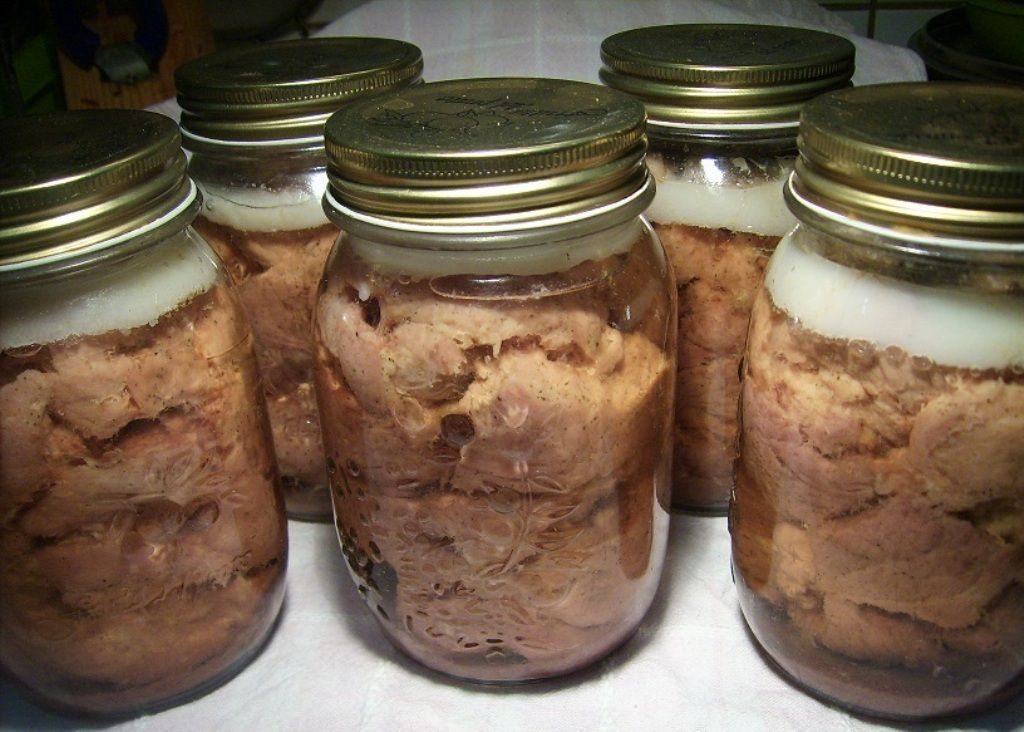
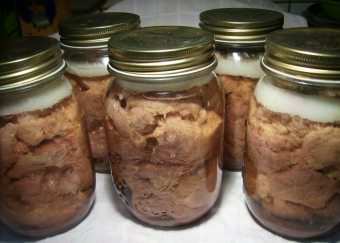
- During the fire, try not to open the door. ovenin order to avoid bursting the jar due to the temperature difference;
- Leave the meat to stew for three hours, then turn off the oven, but do not reach the jar;
- Remove the tare only when the stew has cooled directly in the oven;
- As soon as you do this - immediately roll up the container and put it in a dry, cool place, such as a cellar.
As you can see, there is nothing difficult in preparing the preservation according to such a recipe. But if you do not want or are afraid to stew the meat right in the jar, you can do with more simple cooking instructions.
How to cook stew in a pan or a slow cooker?
If you do not want to cook directly in the oven, you can stew the meat in any other way. Then you will only decompose it into a container and pour melted fat. After that, you need to roll up the cans and also remove the canned food in a cool place.
How to cook stew in a pan:
- Put the meat in a deep frying pan and cover it with water, so that the surface is covered with it;
- Put on a medium heat and start cooking;
- After boiling water, make a weak fire and leave to stew;
- After a few hours (preferably 3-4), salt the meat and add any spices to it (preferably also limited to peas and bay leaves);
- Leave to cook for another couple of hours, if necessary add a little water;
- Simmer the meat only under the lid, and try to open it as little as possible during the cooking process;
- When the dish is ready, turn off the stove and leave the meat to cool;
- After cooling, transfer it to sterile jars and roll up.
Beef stew in a slow cooker is prepared on the same principle, but here everything will be automated. The device must be put on the "quenching" mode for a long time.
If you cook the stew in exactly this way, after sorting it by can, be sure to pour it with melted pork fat. This is necessary to preserve longer stored and more nutritious. Since beef itself is devoid of a large amount of fat, it is for this that lard is taken. It can also soften meat a little and make canned food more tender.
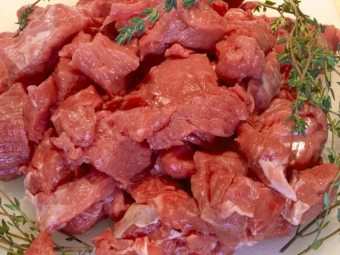
Tara must be sterile. It can be sterilized according to the classical principle - by boiling water and drying.
When folding the preservation of the banks, they must be completely dry. If there is even a drop of water on them, you risk at the end spoiling both the food and the stew obtained by your own efforts.
Try not to add onion and garlic (fresh) to the stew. Remember this is not normal meat stew, which means that it is important to follow the rules for its long-term storage. Unfortunately, the stew, flavored with garlic and onions, quickly deteriorates.
Enjoy your meal!



